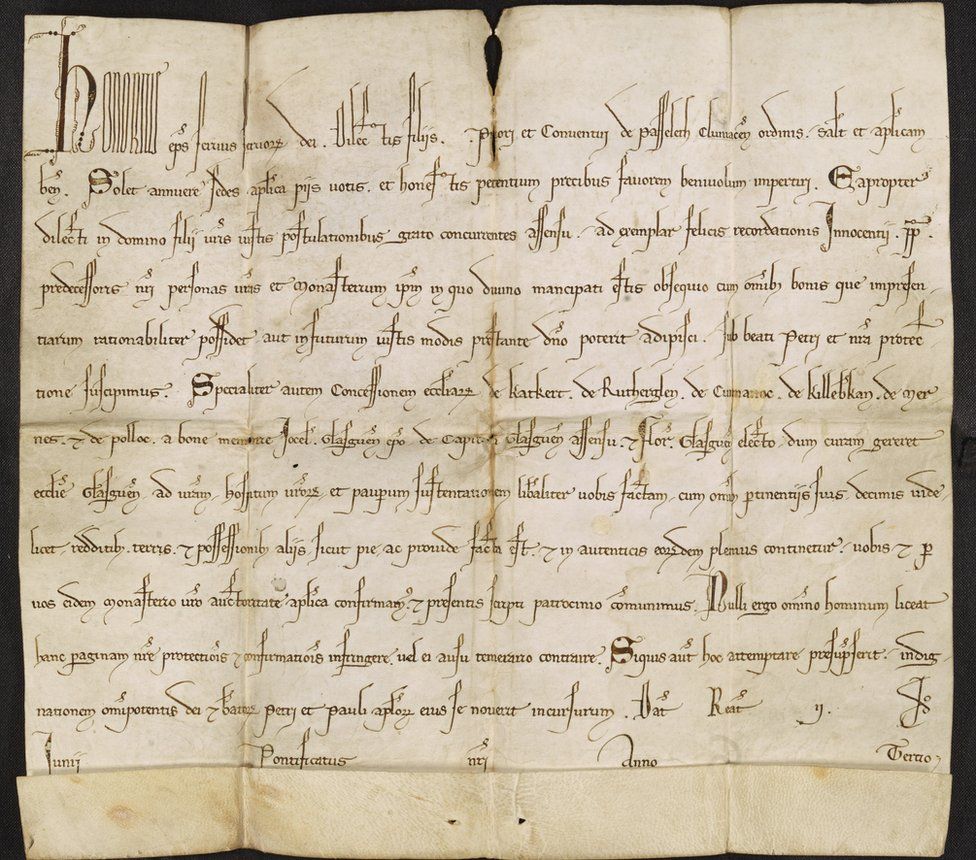Papal Bull: 'Oldest public document' in NI marks links to Scotland
- Published

Historic links with Scotland are being marked as the oldest publicly-owned document in Northern Ireland turns 800 years old.
The document is a Papal Bull (an official document issued by the Pope) which is dated 12 June 1219.
It was issued by Pope Honorius III to grant ownership of a new convent and priory in Paisley, Scotland, to nearby churches in Cathcart, Glasgow.
It was brought from Scotland to Ireland by the Hamilton family 400 years ago.
The Hamiltons were Scottish aristocrats who moved to County Tyrone during the Plantation of Ulster and established a new stately home at the Baronscourt Estate.
The estate's current owner, James Hamilton, Duke of Abercorn, is the most senior aristocrat in Northern Ireland.
A number of years ago, his family deposited a collection of historic documents with the Public Record Office of Northern Ireland (PRONI).
The papers included the 800-year-old Papal Bull, made of sheepskin, which is the oldest document in PRONI's possession.
"It's only four years younger than the Magna Carta, which is probably the seminal document in British history," said Stephen Scarth, head of public services at PRONI.
Papal Bulls take their name from the lead seal, or bulla, that was traditionally attached to the document as a method of authentication.
Mr Scarth said the document was in "remarkably good condition".
"Ink doesn't get absorbed into sheepskin, it just sits on top of sheepskin and doesn't come off," he added.
The curator said the 13th Century scroll had stood the test of time better than some early 20th Century public documents which have not survived.
A free event is taking place in Belfast on Wednesday to celebrate the 800th anniversary of the Papal Bull.
The current Duke of Abercorn's son, James Hamilton, the Marquess of Hamilton, is among the guest speakers.
Who are the Hamiltons?
The Hamiltons settled in Ireland in the early 1600s, as part of the Plantation of Ulster and are still among the most prominent Ulster Scots families in Northern Ireland.
In their native Scotland, Lord Paisley of the Hamilton family had been a strong supporter of the ill-fated Mary Queen of Scots, who was beheaded by Queen Elizabeth I in 1587.
When Elizabeth died in 1603, Mary's son James VI of Scotland inherited her crown, making him king of England and Ireland as well as Scotland.
The new king tasked Lord Paisley's 23-year-old son, James Hamilton, with leading a Scottish settlement in County Tyrone.
James Hamilton was granted thousands of acres of land around Strabane which had been confiscated from Gaelic lords.
He was also given a new title - Earl of Abercorn.
In 1612 the family set up home near Newtownstewart, establishing the Baronscourt Estate, which has been passed down through the generations for more than 400 years.
Successive dukes of Abercorn have held important positions in Anglo-Irish history, including the role of Lord Lieutenant of Ireland and later governor of Northern Ireland.
Baronscourt's current owner, also called James Hamilton, is the 5th Duke of Abercorn.
He is a former Ulster Unionist MP who represented Fermanagh and South Tyrone from 1964 to 1970.
In 1966, the duke married Alexandra Anastasia Hamilton, known as Sacha, whose own family history included links to Russian tsars and assorted European royalty.
She is also a direct descendant of the renowned Russian poet Alexander Pushkin.
The Duchess of Abercorn, who died late last year, was the founder of a cross-community charity set up to help children traumatised by the Troubles in Northern Ireland.
The Pushkin Trust, named after her famous ancestor, helps young people to express themselves through creative writing.